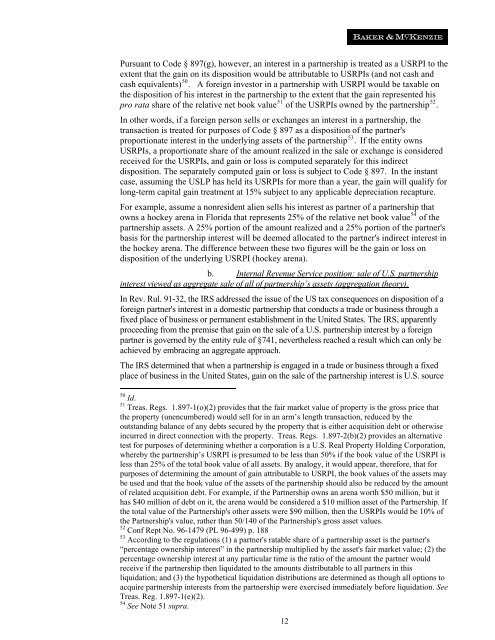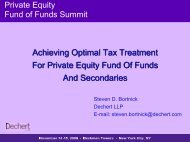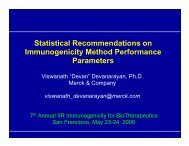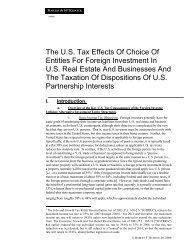The US Tax Effects Of Choice Of Entities For Foreign Investment - IIR
The US Tax Effects Of Choice Of Entities For Foreign Investment - IIR
The US Tax Effects Of Choice Of Entities For Foreign Investment - IIR
You also want an ePaper? Increase the reach of your titles
YUMPU automatically turns print PDFs into web optimized ePapers that Google loves.
Pursuant to Code § 897(g), however, an interest in a partnership is treated as a <strong>US</strong>RPI to the<br />
extent that the gain on its disposition would be attributable to <strong>US</strong>RPIs (and not cash and<br />
cash equivalents) 50 . A foreign investor in a partnership with <strong>US</strong>RPI would be taxable on<br />
the disposition of his interest in the partnership to the extent that the gain represented his<br />
pro rata share of the relative net book value 51 of the <strong>US</strong>RPIs owned by the partnership 52 .<br />
In other words, if a foreign person sells or exchanges an interest in a partnership, the<br />
transaction is treated for purposes of Code § 897 as a disposition of the partner's<br />
proportionate interest in the underlying assets of the partnership 53 . If the entity owns<br />
<strong>US</strong>RPIs, a proportionate share of the amount realized in the sale or exchange is considered<br />
received for the <strong>US</strong>RPIs, and gain or loss is computed separately for this indirect<br />
disposition. <strong>The</strong> separately computed gain or loss is subject to Code § 897. In the instant<br />
case, assuming the <strong>US</strong>LP has held its <strong>US</strong>RPIs for more than a year, the gain will qualify for<br />
long-term capital gain treatment at 15% subject to any applicable depreciation recapture.<br />
<strong>For</strong> example, assume a nonresident alien sells his interest as partner of a partnership that<br />
owns a hockey arena in Florida that represents 25% of the relative net book value 54 of the<br />
partnership assets. A 25% portion of the amount realized and a 25% portion of the partner's<br />
basis for the partnership interest will be deemed allocated to the partner's indirect interest in<br />
the hockey arena. <strong>The</strong> difference between these two figures will be the gain or loss on<br />
disposition of the underlying <strong>US</strong>RPI (hockey arena).<br />
b. Internal Revenue Service position: sale of U.S. partnership<br />
interest viewed as aggregate sale of all of partnership’s assets (aggregation theory).<br />
In Rev. Rul. 91-32, the IRS addressed the issue of the <strong>US</strong> tax consequences on disposition of a<br />
foreign partner's interest in a domestic partnership that conducts a trade or business through a<br />
fixed place of business or permanent establishment in the United States. <strong>The</strong> IRS, apparently<br />
proceeding from the premise that gain on the sale of a U.S. partnership interest by a foreign<br />
partner is governed by the entity rule of §741, nevertheless reached a result which can only be<br />
achieved by embracing an aggregate approach.<br />
<strong>The</strong> IRS determined that when a partnership is engaged in a trade or business through a fixed<br />
place of business in the United States, gain on the sale of the partnership interest is U.S. source<br />
50 Id.<br />
51 Treas. Regs. 1.897-1(o)(2) provides that the fair market value of property is the gross price that<br />
the property (unencumbered) would sell for in an arm’s length transaction, reduced by the<br />
outstanding balance of any debts secured by the property that is either acquisition debt or otherwise<br />
incurred in direct connection with the property. Treas. Regs. 1.897-2(b)(2) provides an alternative<br />
test for purposes of determining whether a corporation is a U.S. Real Property Holding Corporation,<br />
whereby the partnership’s <strong>US</strong>RPI is presumed to be less than 50% if the book value of the <strong>US</strong>RPI is<br />
less than 25% of the total book value of all assets. By analogy, it would appear, therefore, that for<br />
purposes of determining the amount of gain attributable to <strong>US</strong>RPI, the book values of the assets may<br />
be used and that the book value of the assets of the partnership should also be reduced by the amount<br />
of related acquisition debt. <strong>For</strong> example, if the Partnership owns an arena worth $50 million, but it<br />
has $40 million of debt on it, the arena would be considered a $10 million asset of the Partnership. If<br />
the total value of the Partnership's other assets were $90 million, then the <strong>US</strong>RPIs would be 10% of<br />
the Partnership's value, rather than 50/140 of the Partnership's gross asset values.<br />
52 Conf Rept No. 96-1479 (PL 96-499) p. 188<br />
53 According to the regulations (1) a partner's ratable share of a partnership asset is the partner's<br />
“percentage ownership interest” in the partnership multiplied by the asset's fair market value; (2) the<br />
percentage ownership interest at any particular time is the ratio of the amount the partner would<br />
receive if the partnership then liquidated to the amounts distributable to all partners in this<br />
liquidation; and (3) the hypothetical liquidation distributions are determined as though all options to<br />
acquire partnership interests from the partnership were exercised immediately before liquidation. See<br />
Treas. Reg. 1.897-1(e)(2).<br />
54 See Note 51 supra.<br />
12
















